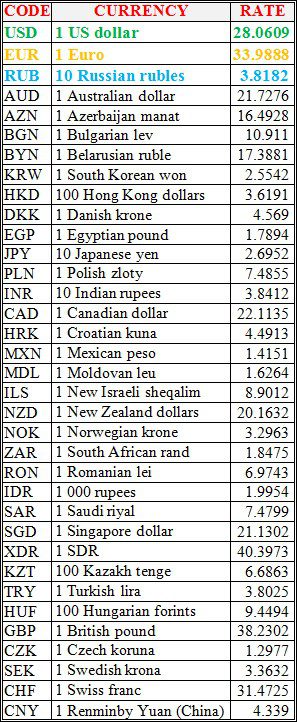
Imports of fresh or chilled fish in 2020 in physical terms increased by one third compared to the previous year, from 23,000 tonnes to 30,000 tonnes, and in U.S. dollar terms it grew by 15.4%, from $141 million to $162 million, the State Customs Service has reported. At that time, according to the data, the import of frozen fish in the past year amounted to 271,000 tonnes worth $365 million, decreasing by 5.1% and 3.1%, respectively.
Due to a general reduction in imports, the share of fresh or chilled fish of it in 2020 increased to 0.30% from 0.23% a year earlier, frozen – from 0.62% to 0.67%, the State Customs Service said.
According to the data, the export of frozen fish in 2020 amounted to only 440 tonnes for $1.1 million, having almost halved.
The State Customs Service said that the largest three countries-suppliers of fresh and chilled fish to Ukraine are Norway with the share of 82%, Turkey with 9% and Iceland with 4%, frozen – the United States with 19%, Iceland with 18%, and Norway with 14%.
In addition, in physical terms the import of fish fillets and other fish meat, dried, salted and smoked fish, crayfish and molluscs grew by 16.9%, to 58,700 tonnes, in money terms – by 20.1% to $152.7 million.
Most of all, the import of crustaceans increased – to 11,500 tonnes and to $55 million, or by 57.4% and 42.6%, respectively.
At the same time, fish fillets and other fish meat remained the main export product in this industry for Ukraine – 3,800 tonnes for $26.3 million, which is 2.5% and 13.4% higher than in 2019, respectively.

The deficit of Ukraine’s foreign trade in goods in January-November 2020 decreased 58.6% compared to January-November 2019, to $3.897 billion from $9.417 billion, the State Statistics Service reported on Thursday.
According to its data, the export of goods from Ukraine for the reporting period compared to the same period in 2019 fell by 3.5%, to $44.347 billion, imports narrowed by 12.9%, to $48.244 billion.
The State Statistics Service said that in November, compared with October 2020, the seasonally adjusted export volume increased 2.5%, to $4.374 billion, imports grew by 4.3%, to $4.791 billion.
The seasonally adjusted foreign trade balance in November 2020 posted a deficit and amounted to $0.417 billion, a month earlier it also showed a deficit being $0.323 billion.
The ratio of exports to imports in January-April of this year amounted to 0.92 (in January-November-2019 it was 0.83).
The State Statistics Service said that foreign trade operations were carried out with partners from 232 countries.

The Ukrainian Embassy has opened a 24-hour hotline line to provide possible assistance to citizens of Ukraine in Indonesia, where a powerful earthquake occurred, spokesman of the Ministry of Foreign Affairs of Ukraine Oleh Nikolenko said.
“A powerful earthquake happened on the island of Sulawesi in Indonesia. To provide possible assistance to Ukrainian citizens, the Ukrainian embassy has opened a 24-hour hotline: +62 87 88 48 90 918. There is still no information about the injured Ukrainians,” Nikolenko wrote on Twitter on Friday.
National bank of Ukraine’s official rates as of 15/01/21

Source: National Bank of Ukraine

Initial registrations of electric vehicles (new and used) in Ukraine in 2020 decreased by 1% (or 87 units) compared to 2019, to 7,455 units, including 91.3% used cars (6,803), according to the Ukrautoprom association.
According to the data on its website, 7,095 passenger cars (of which only 9% are new), 359 commercial vehicles (3% new) and one electric bus (manufactured in 2019) were registered over the year.
At the same time, the average age of the used electric registered passenger cars was five years last year, of commercial vehicles seven years.
Thus, compared to 2019, the registration of used cars in 2020 decreased by 2% (by 135 cars), and new ones increased by 8% (or by 48 cars).
The most popular electric vehicle in Ukraine remains Nissan Leaf with 2,180 registrations, the second place is taken by Tesla Model 3 (some 865 cars), and the third by Tesla Model S (753 cars). The fourth position is taken by Chevrolet Bolt with 474 registrations, and the Tesla Model X closes the top five most popular zero-emission vehicles with 366 registrations per year.
The best result for new electric vehicle sales was shown by Audi E-Tron, which was chosen by 122 buyers.
The commercial electric vehicle market was dominated by Renault Kangoo Z.E. with 304 registrations, including only seven new ones.
The association also said that in December 2020, the Ukrainian vehicle fleet was replenished with 632 electric vehicles, which is 8% more than a year earlier, including 598 cars (more by 7% compared to December 2019) and 34 commercial (more by 36%).
The share of used cars in December last year in the passenger segment was 86%, in the commercial segment 97%.